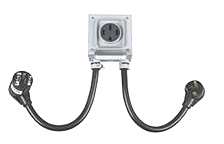
| 30 + 20-amp pigtail cheater plug |
| I do not have any experience with this product. It would be an easy process to make one at home for a lot less than it is available commercially. Looking at it with an open mind I personally wouldn't have any use for it. In my opinion most newer Campgrounds already offer a full 50-amp service or a properly wired 30-amp service. |
|
| Most but not all
Campground Electric hookups have been fine for my needs. I did find a few low voltage and not
properly wired places. I do check all Campground outlets with my homemade
gizmo. (See it under "OUTLET TESTING" on the left)
A correctly wired 120/240-volt 50-amp service will give you 12,000 watts and a 120-volt 30-amp service 3,600 watts. A cheater pigtail if it works, theoretically would give you 6,000 watts. Unfortunately this 6,000 watts is hard to get for a number of reasons. If the campground is wired correctly the 20-amp outlet will be on GFI so the pigtail doesn't work. Most older campgrounds with the 30-amp service will have the 20-amp and the 30-amp wires on the same Main breaker sharing the same HOT and Neutral wire.
I would be concerned switching on appliances with an unknown amount of wattage available with this setup. As I understand it some people are happy with this but I believe an RV with heavy watts demands will have a problem. |
| I leave the technical discussion on this subject to others. If you would like to see some pro and con opinions also some not exactly correct information go to this LINK on RV.NET under Tech Issues. |